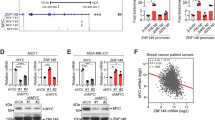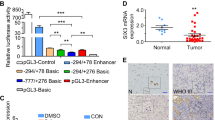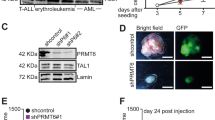Abstract
The Wnt signaling pathway is capable of self-regulation through positive and negative feedback mechanisms. For example, the oncoprotein c-Myc, which is upregulated by Wnt signaling activity, participates in a positive feedback loop of canonical Wnt signaling through repression of Wnt antagonists DKK1 and SFRP1. In this study, we investigated the mechanism of Wnt inhibitory factor-1 (WIF-1) silencing. Mapping of CpG island methylation of the WIF-1 promoter reveals regional methylation (−295 to −95 bp from the transcription start site) that correlates with transcriptional silencing. We identified Miz-1 as a direct activator of WIF-1 transcriptional activity, which is found at WIF-1 promoter. In addition, we show that c-Myc contributes to WIF-1 transcriptional repression in a Miz-1-dependent manner. Although the transient repression mediated by Miz-1/c-Myc is independent of de novo methylation, the stable repression by this complex is associated with CpG island methylation of the critical −295 to −95-bp region of the WIF-1 promoter. Importantly, Miz-1 and c-Myc are found at WIF-1 promoter in WIF-1 non-expressing cell lines DLD-1 and 209myc. Transient knockdown or somatic knockout of c-Myc in DLD-1 failed to restore WIF-1 expression suggesting that c-Myc is involved in initiating rather than maintaining WIF-1 epigenetic silencing. In a genome-wide screen, DNAJA4, TGFβ-induced and TRIM59 were repressed by c-Myc overexpression and DNA promoter hypermethylation. Our data reveal novel insights into c-Myc-mediated DNA methylation-dependent transcriptional silencing, a mechanism that might contribute to the dysregulation of Wnt signaling in cancer.
This is a preview of subscription content, access via your institution
Access options
Subscribe to this journal
Receive 50 print issues and online access
$259.00 per year
only $5.18 per issue
Buy this article
- Purchase on Springer Link
- Instant access to full article PDF
Prices may be subject to local taxes which are calculated during checkout







Similar content being viewed by others
Abbreviations
- ChIP:
-
chromatin immunoprecipitation
- MSP:
-
methylation-specific PCR
- NSCLC:
-
non-small cell lung cancer
- TSS:
-
transcription start site
- WIF-1 :
-
Wnt inhibitory factor-1
References
Ahmed AA, Mills AD, Ibrahim AE, Temple J, Blenkiron C, Vias M et al. (2007). The extracellular matrix protein TGFBI induces microtubule stabilization and sensitizes ovarian cancers to paclitaxel. Cancer Cell 12: 514–527.
Ai L, Tao Q, Zhong S, Fields CR, Kim WJ, Lee MW et al. (2006). Inactivation of Wnt inhibitory factor-1 (WIF1) expression by epigenetic silencing is a common event in breast cancer. Carcinogenesis 27: 1341–1348.
Barr LF, Campbell SE, Diette GB, Gabrielson EW, Kim S, Shim H et al. (2000). c-Myc suppresses the tumorigenicity of lung cancer cells and down-regulates vascular endothelial growth factor expression. Cancer Res 60: 143–149.
Benanti JA, Wang ML, Myers HE, Robinson KL, Grandori C, Galloway DA . (2007). Epigenetic down-regulation of ARF expression is a selection step in immortalization of human fibroblasts by c-Myc. Mol Cancer Res 5: 1181–1189.
Bowen H, Biggs TE, Phillips E, Baker ST, Perry VH, Mann DA et al. (2002). c-Myc represses and Miz-1 activates the murine natural resistance-associated protein 1 promoter. J Biol Chem 277: 34997–35006.
Brenner C, Deplus R, Didelot C, Loriot A, Vire E, De Smet C et al. (2005). Myc represses transcription through recruitment of DNA methyltransferase corepressor. EMBO J 24: 336–346.
Bush A, Mateyak M, Dugan K, Obaya A, Adachi S, Sedivy J et al. (1998). c-myc null cells misregulate cad and gadd45 but not other proposed c-Myc targets. Genes Dev 12: 3797–3802.
Chan SL, Cui Y, van Hasselt A, Li H, Srivastava G, Jin H et al. (2007). The tumor suppressor Wnt inhibitory factor 1 is frequently methylated in nasopharyngeal and esophageal carcinomas. Lab Invest 87: 644–650.
Chen ZX, Mann JR, Hsieh CL, Riggs AD, Chedin F . (2005). Physical and functional interactions between the human DNMT3L protein and members of the de novo methyltransferase family. J Cell Biochem 95: 902–917.
Cowling VH, D′Cruz CM, Chodosh LA, Cole MD . (2007). c-Myc transforms human mammary epithelial cells through repression of the Wnt Inhibitors DKK1 and SFRP1. Mol Cell Biol 27: 5135–5146.
de la Roche M, Worm J, Bienz M . (2008). The function of BCL9 in Wnt/beta-catenin signaling and colorectal cancer cells. BMC Cancer 8: 199.
Di Croce L, Raker VA, Corsaro M, Fazi F, Fanelli M, Faretta M et al. (2002). Methyltransferase recruitment and DNA hypermethylation of target promoters by an oncogenic transcription factor. Science 295: 1079–1082.
Finlan LE, Sproul D, Thomson I, Boyle S, Kerr E, Perry P et al. (2008). Recruitment to the nuclear periphery can alter expression of genes in human cells. PLoS Genet 4: e1000039.
Gartel AL, Ye X, Goufman E, Shianov P, Hay N, Najmabadi F et al. (2001). Myc represses the p21(WAF1/CIP1) promoter and interacts with Sp1/Sp3. Proc Natl Acad Sci USA 98: 4510–4515.
Gebhardt A, Frye M, Herold S, Benitah SA, Braun K, Samans B et al. (2006). Myc regulates keratinocyte adhesion and differentiation via complex formation with Miz1. J Cell Biol 172: 139–149.
Guarda A, Bolognese F, Bonapace IM, Badaracco G . (2009). Interaction between the inner nuclear membrane lamin b receptor and the heterochromatic methyl binding protein, MeCP2. Exp Cell Res 315: 18903 .
Gujral TS, MacBeath G . (2009). Emerging miniaturized proteomic technologies to study cell signaling in clinical samples. Sci Signal 2: pe65.
Halaban R, Krauthammer M, Pelizzola M, Cheng E, Kovacs D, Sznol M et al. (2009). Integrative analysis of epigenetic modulation in melanoma cell response to decitabine: clinical implications. PLoS One 4: e4563.
He TC, Sparks AB, Rago C, Hermeking H, Zawel L, da Costa LT et al. (1998). Identification of c-MYC as a target of the APC pathway. Science 281: 1509–1512.
Herman JG, Baylin SB . (2003). Gene silencing in cancer in association with promoter hypermethylation. N Engl J Med 349: 2042–2054.
Hsieh JC, Kodjabachian L, Rebbert ML, Rattner A, Smallwood PM, Samos CH et al. (1999). A new secreted protein that binds to Wnt proteins and inhibits their activities. Nature 398: 431–436.
Ikegaki N, Gotoh T, Kung B, Riceberg JS, Kim DY, Zhao H et al. (2007). De novo identification of MIZ-1 (ZBTB17) encoding a MYC-interacting zinc-finger protein as a new favorable neuroblastoma gene. Clin Cancer Res 13: 6001–6009.
Li H, Rauch T, Chen ZX, Szabo PE, Riggs AD, Pfeifer GP . (2006). The histone methyltransferase SETDB1 and the DNA methyltransferase DNMT3A interact directly and localize to promoters silenced in cancer cells. J Biol Chem 281: 19489–19500.
Li Z, Luo RT, Mi S, Sun M, Chen P, Bao J et al. (2009). Consistent deregulation of gene expression between human and murine MLL rearrangement leukemias. Cancer Res 69: 1109–1116.
Licchesi JD, Westra WH, Hooker CM, Machida EO, Baylin SB, Herman JG . (2008). Epigenetic alteration of Wnt pathway antagonists in progressive glandular neoplasia of the lung. Carcinogenesis 29: 895–904.
Liu X, Mazanek P, Dam V, Wang Q, Zhao H, Guo R et al. (2008). Deregulated Wnt/beta-catenin program in high-risk neuroblastomas without MYCN amplification. Oncogene 27: 1478–1488.
Mazieres J, He B, You L, Xu Z, Lee AY, Mikami I et al. (2004). Wnt inhibitory factor-1 is silenced by promoter hypermethylation in human lung cancer. Cancer Res 64: 4717–4720.
McGarvey KM, Fahrner JA, Greene E, Martens J, Jenuwein T, Baylin SB . (2006). Silenced tumor suppressor genes reactivated by DNA demethylation do not return to a fully euchromatic chromatin state. Cancer Res 66: 3541–3549.
Osborne CS, Chakalova L, Mitchell JA, Horton A, Wood AL, Bolland DJ et al. (2007). Myc dynamically and preferentially relocates to a transcription factory occupied by Igh. PLoS Biol 5: e192.
Patel JH, McMahon SB . (2006). Targeting of Miz-1 is essential for Myc-mediated apoptosis. J Biol Chem 281: 3283–3289.
Patel JH, McMahon SB . (2007). BCL2 is a downstream effector of MIZ-1 essential for blocking c-MYC-induced apoptosis. J Biol Chem 282: 5–13.
Perini G, Diolaiti D, Porro A, Della Valle G . (2005). In vivo transcriptional regulation of N-Myc target genes is controlled by E-box methylation. Proc Natl Acad Sci USA 102: 12117–12122.
Peukert K, Staller P, Schneider A, Carmichael G, Hanel F, Eilers M . (1997). An alternative pathway for gene regulation by Myc. EMBO J 16: 5672–5686.
Reguart N, He B, Xu Z, You L, Lee AY, Mazieres J et al. (2004). Cloning and characterization of the promoter of human Wnt inhibitory factor-1. Biochem Biophys Res Commun 323: 229–234.
Rhee I, Bachman KE, Park BH, Jair KW, Yen RW, Schuebel KE et al. (2002). DNMT1 and DNMT3b cooperate to silence genes in human cancer cells. Nature 416: 552–556.
Rountree MR, Bachman KE, Baylin SB . (2000). DNMT1 binds HDAC2 and a new co-repressor, DMAP1, to form a complex at replication foci. Nat Genet 25: 269–277.
Schuebel KE, Chen W, Cope L, Glockner SC, Suzuki H, Yi JM et al. (2007). Comparing the DNA hypermethylome with gene mutations in human colorectal cancer. PLoS Genet 3: 1709–1723.
Seoane J, Pouponnot C, Staller P, Schader M, Eilers M, Massague J . (2001). TGFbeta influences Myc, Miz-1 and Smad to control the CDK inhibitor p15INK4b. Nat Cell Biol 3: 400–408.
Seoane J, Le HV, Massague J . (2002). Myc suppression of the p21(Cip1) Cdk inhibitor influences the outcome of the p53 response to DNA damage. Nature 419: 729–734.
Shah JN, Shao G, Hei TK, Zhao Y . (2008). Methylation screening of the TGFBI promoter in human lung and prostate cancer by methylation-specific PCR. BMC Cancer 8: 284.
Smale ST, Baltimore D . (1989). The ‘initiator’ as a transcription control element. Cell 57: 103–113.
Staller P, Peukert K, Kiermaier A, Seoane J, Lukas J, Karsunky H et al. (2001). Repression of p15INK4b expression by Myc through association with Miz-1. Nat Cell Biol 3: 392–399.
Tang Y, Simoneau AR, Liao WX, Yi G, Hope C, Liu F et al. (2009). WIF1, a Wnt pathway inhibitor, regulates SKP2 and c-myc expression leading to G1 arrest and growth inhibition of human invasive urinary bladder cancer cells. Mol Cancer Ther 8: 458–468.
Taniguchi H, Yamamoto H, Hirata T, Miyamoto N, Oki M, Nosho K et al. (2005). Frequent epigenetic inactivation of Wnt inhibitory factor-1 in human gastrointestinal cancers. Oncogene 24: 7946–7952.
Tiwari VK, McGarvey KM, Licchesi JD, Ohm JE, Herman JG, Schubeler D et al. (2008). PcG proteins, DNA methylation, and gene repression by chromatin looping. PLoS Biol 6: 2911–2927.
Urakami S, Shiina H, Enokida H, Kawakami T, Tokizane T, Ogishima T et al. (2006). Epigenetic inactivation of Wnt inhibitory factor-1 plays an important role in bladder cancer through aberrant canonical Wnt/beta-catenin signaling pathway. Clin Cancer Res 12: 383–391.
van de Wetering M, Sancho E, Verweij C, de Lau W, Oving I, Hurlstone A et al. (2002). The beta-catenin/TCF-4 complex imposes a crypt progenitor phenotype on colorectal cancer cells. Cell 111: 241–250.
Villa R, Pasini D, Gutierrez A, Morey L, Occhionorelli M, Vire E et al. (2007). Role of the polycomb repressive complex 2 in acute promyelocytic leukemia. Cancer Cell 11: 513–525.
Wu S, Cetinkaya C, Munoz-Alonso MJ, von der Lehr N, Bahram F, Beuger V et al. (2003). Myc represses differentiation-induced p21CIP1 expression via Miz-1-dependent interaction with the p21 core promoter. Oncogene 22: 351–360.
Yu L, Liu C, Vandeusen J, Becknell B, Dai Z, Wu YZ et al. (2005). Global assessment of promoter methylation in a mouse model of cancer identifies ID4 as a putative tumor-suppressor gene in human leukemia. Nat Genet 37: 265–274.
Zhang Y, Wen G, Shao G, Wang C, Lin C, Fang H et al. (2009). TGFBI deficiency predisposes mice to spontaneous tumor development. Cancer Res 69: 37–44.
Zinn RL, Pruitt K, Eguchi S, Baylin SB, Herman JG . (2007). hTERT is expressed in cancer cell lines despite promoter DNA methylation by preservation of unmethylated DNA and active chromatin around the transcription start site. Cancer Res 67: 194–201.
Acknowledgements
We acknowledge Dr Martin Eilers (Marbourg University, Germany), Dr Arthur Riggs (Beckman Research Institute, Duarte, CA, USA) and Dr Bert Vogelstein (Johns Hopkins School of Medicine, USA) for plasmids, Dr Kurt Bachman (University of Maryland, USA) for the DLD-1 c-Myc −/− DNA and cDNA. We are grateful to Dr Wayne Yu at the Johns Hopkins Microarray Core facility, Dr Kornel Schuebel for his help with the microarray experiment and Dr Mariann Bienz for her support. Finally, we thank all the members of the Baylin/Herman laboratory for useful discussions and Kathy Bender for administrative assistance. This study was supported by NCI/SPORE grant CA058184 to James G Herman, AICR grant 07-0040 to Mariann Bienz (MRC-LMB) and NCI grant P30 CA06973-44 to Leslie Cope.
Author information
Authors and Affiliations
Corresponding authors
Ethics declarations
Competing interests
The commercial rights to the MSP technique belong to OncoMethylome Sciences. SBB and JGH serve as consultants to OncoMethylome Sciences and are entitled to royalties from any commercial use of this procedure. SBB and JGH also receive research support from OncoMethylome Sciences. The terms of this arrangement are being managed by the Johns Hopkins University in accordance with its conflict of interest policies.
Additional information
Supplementary Information accompanies the paper on the Oncogene website
Rights and permissions
About this article
Cite this article
Licchesi, J., Van Neste, L., Tiwari, V. et al. Transcriptional regulation of Wnt inhibitory factor-1 by Miz-1/c-Myc. Oncogene 29, 5923–5934 (2010). https://doi.org/10.1038/onc.2010.322
Received:
Revised:
Accepted:
Published:
Issue Date:
DOI: https://doi.org/10.1038/onc.2010.322
Keywords
This article is cited by
-
CDC42 as an epigenetic regulator of ID4 in triple-negative breast tumors
Breast Cancer (2022)
-
Analysis of DNA methylation in cancer: location revisited
Nature Reviews Clinical Oncology (2018)
-
The Wnt signalling pathway is upregulated in an in vitro model of acquired tamoxifen resistant breast cancer
BMC Cancer (2013)
-
Promoter hypermethylation-induced transcriptional down-regulation of the gene MYCT1in laryngeal squamous cell carcinoma
BMC Cancer (2012)



